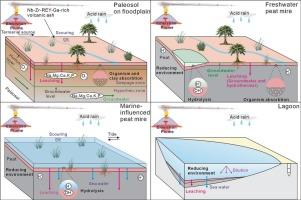沉积环境对黔西晚二叠世煤系关键金属富集的控制
IF 3.6
2区 地球科学
Q1 GEOLOGY
引用次数: 0
摘要
顾名思义,关键金属对现代社会至关重要,了解它们是如何形成的以及在哪里形成的,对于有针对性地勘探新资源至关重要。晚二叠世,由于峨眉山大火成岩省(ELIP)碱性火山灰的输入,在黔西煤系(龙滩组中下段)内形成了多个富集Nb-Zr-REY(稀土元素和Y) - ga的煤层(称为含金属煤),这些煤层表现出异常高的自然伽马测井(GR)正异常。矿层以GR值>为特征;2.0 pA/kg在岩层和>;相邻煤层1.6 pA/kg。矿床的沉积环境既控制着矿床的形成,又控制着矿床中关键金属的富集。矿床分布在四种相上:冲积平原古土壤、淡水泥炭矿、海洋影响泥炭矿和泻湖,相应的岩性组合有:煤—煤、古土壤—煤、煤和碳质泥岩。在受海洋影响的泥炭沼泽环境中形成的煤中发现了最高浓度的关键金属。酸雨和大气水的淋滤、泥炭和粘土矿物的吸附作用、酸性和还原环境的存在、海水的入侵以及植物生长的影响都对提高临界金属的富集起作用。含金属煤煤灰中Nb、Zr、REY和Ga的平均浓度分别为813.80、5178.58、1255.21和117.01 μg/g。可采煤层数1 ~ 2条,平均厚度1.98 m。可采含金属煤灰中临界金属储量分别为7.81 × 105 t (Nb)、4.97 × 106 t (Zr)、1.21 × 106 t (REY)和1.12 × 105 t (Ga)。然而,煤灰不仅富含关键金属,还富含Pb、Cr、Th、U等对健康有害的元素,并含有丰富的纳米级石英颗粒,对人体健康构成重大威胁。我们的研究结果为沉积层中关键金属的勘探做出了宝贵的贡献,并进一步证明了在日益循环的经济中,高效、清洁地利用煤灰作为金属资源的潜力。本文章由计算机程序翻译,如有差异,请以英文原文为准。

Sedimentary environment controls on critical metals enrichment in late Permian coal measures in western Guizhou, China
Critical metals are, as the name suggests, critical to modern society and understanding how and where they form is essential for targeted exploration for new resources. In the late Permian, the input of alkaline volcanic ash from the Emeishan Large Igneous Province (ELIP) led to the formation of multiple Nb–Zr–REY (rare earth elements and Y)–Ga-enriched coal seams (called metalliferous coals) within the coal measures (middle-lower Longtan Formation) in western Guizhou, which exhibiting exceptionally high natural gamma-ray log (GR) positive anomalies. Ore beds are characterized by GR values > 2.0 pA/kg in rock layers and > 1.6 pA/kg in adjacent coal seams. The sedimentary environment of deposition controls both the formation of ore beds and the enrichment of critical metals within them. Ore beds are distributed across four facies: floodplain paleosols, freshwater peat mires, marine-influenced peat mires, and lagoons, with four corresponding lithological associations: tonstein–coal, paleosol–coal, coal, and carbonaceous mudstone. The highest concentrations of critical metals are found in tonstein–coals that formed in marine–influenced peat mire environments. Leaching by acid rain and meteoric water, adsorption effects of peat and clay minerals, the presence of acidic and reducing environments, seawater incursion, and the effects of plant growth all play a role in enhancing critical metals enrichment. The coal ash from metalliferous coals contains average concentrations of Nb, Zr, REY, and Ga of 813.80 μg/g, 5,178.58 μg/g, 1,255.21 μg/g, and 117.01 μg/g, respectively. The number of minable seams is one or two, with an average thickness of 1.98 m. The critical metals reserves in minable metalliferous coal ash are estimated at 7.81 × 105 t (Nb), 4.97 × 106 t (Zr), 1.21 × 106 t (REY), and 1.12 × 105 t (Ga). However, the coal ash is enriched not only with critical metals but also with elements harmful to health such as Pb, Cr, Th, and U, along with abundant nano–scale quartz particles, posing substantial threats to human health. Our findings represent a valuable contribution to exploration for critical metals in sedimentary successions and furthermore demonstrate potential for efficient and clean utilization of coal ash as a metal resource in an increasingly circular economy.
求助全文
通过发布文献求助,成功后即可免费获取论文全文。
去求助
来源期刊

Ore Geology Reviews
地学-地质学
CiteScore
6.50
自引率
27.30%
发文量
546
审稿时长
22.9 weeks
期刊介绍:
Ore Geology Reviews aims to familiarize all earth scientists with recent advances in a number of interconnected disciplines related to the study of, and search for, ore deposits. The reviews range from brief to longer contributions, but the journal preferentially publishes manuscripts that fill the niche between the commonly shorter journal articles and the comprehensive book coverages, and thus has a special appeal to many authors and readers.
 求助内容:
求助内容: 应助结果提醒方式:
应助结果提醒方式:


